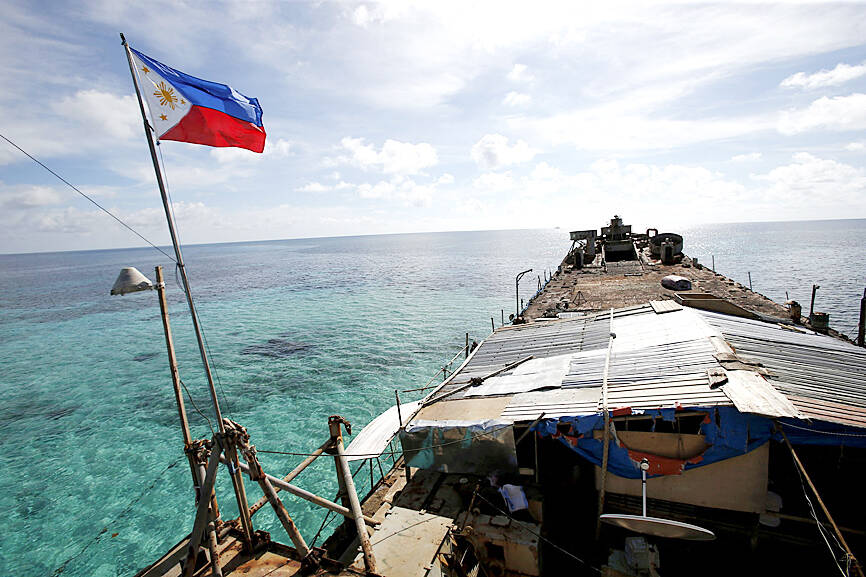A US-funded project to expand a Philippine civilian port facing a strategically crucial channel could assist US allies in the Pacific, including Taiwan, in the event of a conflict with China, military experts said.
Kyodo News on Saturday last week reported that work to expand the port facing the Bashi Channel — a project first announced last year — was under way.
The report cited Batanes Governor Marilou Cayco at a Philippine Navy event saying that the plan, developed in coordination with the Philippine military, aimed to help its citizens leave Taiwan in the event of a cross-strait crisis.

Photo: Reuters
The US Army is to arrive late next month to further discuss the new facility, the report quoted Cayco as saying.
Batanes is the northernmost province of the Philippines. One of its islands, Mavudis, is closest to Taiwan, just 99km from Orchid Island (Lanyu, 蘭嶼) and about 142km from Oluanpi (鵝鑾鼻), Taiwan proper’s southernmost tip.
Institute for National Defense and Security Research research fellow Su Tzu-yun (蘇紫雲) on Tuesday told reporters that despite the port’s stated function, it is really a preventative move by the US to bolster its crisis management ability.
The planned port does not signal an increased risk of war between Taiwan and China, but is rather part of the US deterrence strategy targeting China.
Guermantes Lailari, a visiting researcher at the institute, agreed that the expansion of the port was a “defensive act” by Washington and Manila, and did not necessarily signal a rising risk of a cross-strait conflict.
The port could function as a commercial facility, but it could also be used for military purposes if needed, said Lailari, a retired US Air Force lieutenant colonel.
The Philippines wanted to expand the port, which is “very small,” so that it can handle larger ships, he said.
On the strategic significance of the port’s expansion, Su said it would enable the US to blockade Chinese People’s Liberation Army (PLA) forces from reaching waters east of Taiwan through the Bashi Channel.
The port also relates to Taiwan and Japan’s strategy of blocking China from crossing the first island chain, a string of islands that run from the Japanese archipelago, through Taiwan, the Philippines and on to Borneo, he said.
The Philippines has also deployed BrahMos anti-ship missiles in Basco on the Batan Islands, he said.
The move, along with Japan deploying anti-ship missile systems in the Miyako Strait on its Yonaguni and Miyako islands, and Taiwan’s Hsiung Feng anti-ship missiles, forms a north-south blockade against China, Su added.
The port was part of a strategy covering the northern and southern parts of Taiwan, referencing the deployments of Japan Self Defense Forces and their anti-ship capabilities near the Senkaku Islands, Lailari said.
Taiwan claims the Senkakus, calling them the Diaoyutai Islands (釣魚台).
The Batanes port is strategic given its proximity to Taiwan and that US forces can operate from it.
In addition, under the Enhanced Defense Cooperation Agreement between the US and the Philippines, which was signed in 2014, the US can also access nine other sites.
If China were to invade Taiwan, the PLA would need to send forces through the Bashi Strait to the east of the country to stop incoming support from the US and Taiwan’s other allies, Lailari said.
The port’s location could be great for intelligence collection and monitoring PLA ship and aircraft movements, he said.
Should there be a need for power projection from the Philippines in support of Taiwan, Batanes would also be an ideal location from which forces, equipment or weapons could be sent, he said.
The port expansion shows that the US is helping Taiwan’s neighbors prepare for conflict, Lailari said.
“By increasing defense, you’re also increasing deterrence,” he said. “This sends a message to communist China that the US is serious. And hopefully, [Chinese President] Xi Jinping [習近平] will decide not to do anything.”

ALIGNED THINKING: Taiwan and Japan have a mutual interest in trade, culture and engineering, and can work together for stability, Cho Jung-tai said Taiwan and Japan are two like-minded countries willing to work together to form a “safety barrier” in the Indo-Pacific region, Premier Cho Jung-tai (卓榮泰) yesterday said at the opening ceremony of the 35th Taiwan-Japan Modern Engineering and Technology Symposium in Taipei. Taiwan and Japan are close geographically and closer emotionally, he added. Citing the overflowing of a barrier lake in the Mataian River (馬太鞍溪) in September, Cho said the submersible water level sensors given by Japan during the disaster helped Taiwan monitor the lake’s water levels more accurately. Japan also provided a lot of vaccines early in the outbreak of the COVID-19 pandemic,

Kaohsiung Mayor Chen Chi-mai (陳其邁) on Monday announced light shows and themed traffic lights to welcome fans of South Korean pop group Twice to the port city. The group is to play Kaohsiung on Saturday as part of its “This Is For” world tour. It would be the group’s first performance in Taiwan since its debut 10 years ago. The all-female group consists of five South Koreans, three Japanese and Tainan’s Chou Tzu-yu (周子瑜), the first Taiwan-born and raised member of a South Korean girl group. To promote the group’s arrival, the city has been holding a series of events, including a pop-up

TEMPORAL/SPIRITUAL: Beijing’s claim that the next Buddhist leader must come from China is a heavy-handed political maneuver that will fall flat-faced, experts said China’s requirement that the Dalai Lama’s reincarnation to be born in China and approved by Beijing has drawn criticism, with experts at a forum in Taipei yesterday saying that if Beijing were to put forth its own Dalai Lama, the person would not be recognized by the Tibetan Buddhist community. The experts made a remarks at the two-day forum hosted by the Tibet Religious Foundation of His Holiness the Dalai Lama titled: “The Snow Land Forum: Finding Common Ground on Tibet.” China says it has the right to determine the Dalai Lama’s reincarnation, as it claims sovereignty over Tibet since ancient times,

Temperatures in some parts of Taiwan are expected to fall sharply to lows of 15°C later this week as seasonal northeasterly winds strengthen, the Central Weather Administration (CWA) said today. It is to be the strongest cold wave to affect northern Taiwan this autumn, while Chiayi County in the southwest and some parts of central Taiwan are likely to also see lower temperatures due to radiational cooling, which occurs under conditions of clear skies, light winds and dry weather, the CWA said. Across Taiwan, temperatures are to fall gradually this week, dropping to 15°C to 16°C in the early hours of Wednesday